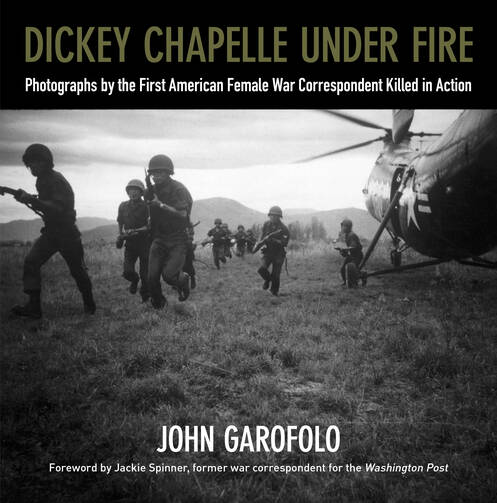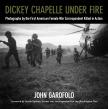Photos from the front lines
My husband spent four years in Saigon as a foreign correspondent during the Vietnam War. I like war stories—coming from correspondents they are invariably self-deprecating and mordantly hilarious. I like my husband’s war stories so much that I enjoy my favorites over and over. One of these favorites concerns an intrepid British woman correspondent and a bunch of male reporters, all confronted by a large rat in a Saigon bar. Needless to say, the male reporters all acted like little girls, but the woman correspondent stepped right up to the rat, grabbed it by the tail, swung it over her head and tossed it out the window. I love that story.
I was a World War II child in the age of comic book heroine Brenda Starr. If the war didn’t last long enough for me to become a Wave (a female Navy officer who belonged to Women Accepted for Volunteer Emergency Service), I was definitely going to be a reporter like Brenda. I distinctly remember being impressed by a picture of Marguerite Higgins, the famous Korean War correspondent, in a jeep wearing a helmet and army fatigues. In the early 1960s, I briefly became a reporter at Life Magazine. One of the special treats was occasionally seeing Margaret Bourke-White, the great photographer, when she dropped into the office. Later on, I came to know the glamourous Martha Gellhorn, famous for covering the Spanish Civil War and for meeting and marrying Hemingway. Later, I was lucky enough to call Gloria Emerson, The New York Times’ woman in Vietnam, a friend.
Dickey Chapelle, of Dickey Chapelle Under Fire, by John Garofolo, is a great member of that intrepid sisterhood of women correspondents—with the terrible distinction of being the first American female correspondent to be killed in action. Dickey died on the battlefield in Vietnam. But she was already a legend in her lifetime and intrepid since childhood. Georgette Meyer was born in Wisconsin, a descendent of pacifist Germans of the 1848 Karl Schurz generation, but she called herself “Dickey” for her hero: Admiral Richard Byrd, explorer of the South Pole. She wanted more than anything to fly planes, but her eyesight wasn’t good enough. At age 16, she won a scholarship to the Massachusetts Institute of Technology to study aeronautical engineering but flunked out because she spent all her time at the Boston Naval Air station. After M.I.T., she lived with her grandparents in Florida and worked as an air show reporter. Covering an air show in Havana, she saw a Cuban pilot crash and die. With journalistic presence of mind, 18-year-old Dickey found a pay phone and called The New York Times. That byline got her a publicity job with Transcontinental and Western Air.
Dickey died on the battlefield in Vietnam. But she was already a legend in her lifetime and intrepid since childhood.
In 1940 Dickey met and married her husband Tony Chapelle, a photographer for Trans World Airline who gave weekly photography lessons. “It doesn’t matter what you’ve seen with your eyes,” he told his students. “If you can’t prove it with a picture, it didn’t happen.” When World War II broke out, Tony, who had served in the Navy during World War I, reenlisted as a chief photographer’s mate. Tony was assigned to Panama, and Dickey followed on assignment from Look Magazine, to cover combat training for the Army’s 14th Infantry Division. Between 1943 and 1944, when Tony was reassigned to the Navy Pictorial Station in Astoria, Queens, Dickey wrote eight books, including one about women in aviation. In 1945 Fawcett Publicans offered Dickey an assignment to cover the war in the Pacific. Tony objected (three photographers he had trained in Panama had been killed in action), but Dickey went anyway. In January 1945, she became the first female photographer accredited to the Navy. Assigned to a hospital ship lying off the coast of Iwo Jima, Dickey photographed doctors, nurses, Marines and sailors treating the enormous stream of casualties. Eventually permitted to go on the island, her picture of a dying Marine on Iwo Jima was her most reproduced photo before Vietnam. On Okinawa, 26-year-old Dickey, looking for combat action, was placed “under arrest in quarters” for disobeying an admiral’s orders not to go ashore.
In the 1950s Dickey began covering the so-called small political wars—usually on the side of rebels. Her “small” wars included the Battle of Algiers against the French; Fidel Castro’s rebellion against the Cuban dictator Batista; and Hungarian Freedom Fighters against the Soviet Union. In Hungary, Dickey was arrested by the Russians and imprisoned for two months. In 1961 she went to Southeast Asia to cover U.S. advisors in Vietnam and Laos. In 1962 she returned home for the publication of her George Polk Award-winning book What’s a Woman Doing Here?. Her photo of South Vietnamese soldiers crowded around a U.S. Marine advisor on a helicopter won the 1963 National Press Photographers Association Photograph of the Year award.
On Nov. 4, 1965, while attached to the U.S. Seventh Marines on a search-and-destroy mission, Dickey was killed by shrapnel from an explosion. “I knew this was bound to happen,” were her final words, whispered to the chaplain giving her the last rites. Her body went home with a Marine escort, and she had a military funeral. Like all correspondents, Dickey had learned to love and respect the men who didn’t start their country’s wars but sacrificed their youth to finish them. “She was one of us, and we will miss her,” said the commandant of the Marine Corps.
This article also appeared in print, under the headline “Photos from the front lines,” in the July 24,2017, issue.











